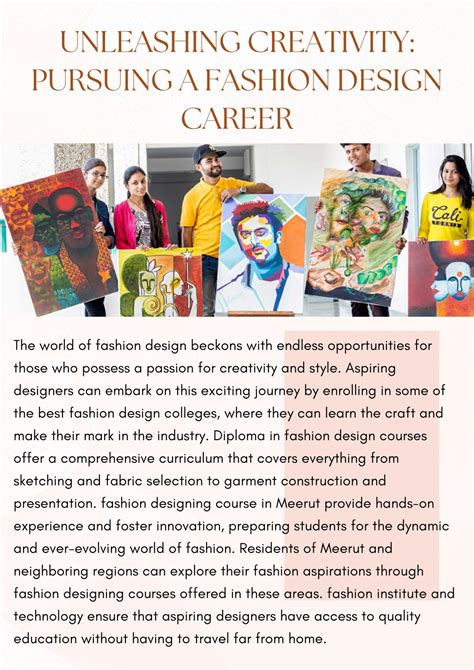Are you passionate about design, fascinated by the intricate balance of form and function, and eager to make a lasting impact on the built environment? If so, pursuing a career as an architect may be the perfect fit for your creative ambitions. In this blog post, we will delve into the world of architecture, exploring the essential principles of architectural design, the development of technical skills, and the rich inspiration to be found in architectural history. We will also discuss the challenges of project management, the integration of sustainable practices, and the use of technology to enhance creativity. Additionally, we will explore the art of collaborating with clients, building a strong architectural community, and the importance of continuing education to stay ahead in this dynamic field. Join us as we unleash the creative potential of a career in architecture and discover how you can make your mark in this exciting and rewarding profession.
Table of Contents
Exploring Architectural Design Principles
Architectural design principles are the fundamental guidelines that architects use to create successful buildings and structures. These principles encompass a wide range of considerations, including aesthetics, functionality, efficiency, and sustainability. By understanding and exploring these principles, architects can develop unique and innovative designs that not only meet the needs of their clients but also contribute to the built environment in a meaningful way.
One of the key architectural design principles is proportion, which refers to the relationship between various elements within a building or structure. Achieving the right proportion is essential for creating a sense of visual harmony and balance. Architects use mathematical ratios and scale to carefully consider the size and placement of doors, windows, columns, and other architectural elements.
Balance is another important design principle that architects consider. Balance refers to the distribution of visual weight in a building or structure. Symmetrical balance, in which elements are evenly distributed on either side of a central axis, creates a sense of stability and order. On the other hand, asymmetrical balance, which involves the use of different elements to create visual equilibrium, can result in a more dynamic and interesting design.
Architects also explore the principle of rhythm in architectural design, which involves the repetition and variation of elements to create visual interest and movement. By establishing a consistent rhythm through the use of patterns, colors, textures, and shapes, architects can guide the eye and create a sense of flow within a space.
Developing Technical Skills in Architecture
Developing technical skills in architecture is a crucial step in becoming a successful architect. From mastering software programs to understanding building materials and construction techniques, there are many aspects to consider in the development of technical skills.
One of the first steps in developing technical skills is to acquire proficiency in computer-aided design (CAD) software. CAD programs are essential tools for architects, allowing them to create detailed, precise drawings and models. By mastering CAD software, architects can enhance their ability to visualize and communicate their design ideas.
In addition to CAD software, architects must also have a strong understanding of building materials and construction methods. This knowledge is essential for designing structures that are not only visually appealing, but also safe and functional. Understanding the properties of different materials and how they can be used in construction is a key technical skill for architects.
Lastly, developing technical skills in architecture also involves staying up to date with the latest technological advancements in the industry. Whether it’s new materials, construction techniques, or sustainable design practices, architects must continuously expand their technical knowledge to remain competitive in the field.
Finding Inspiration in Architectural History
When it comes to creating innovative and impactful architectural designs, drawing inspiration from the past can be a game changer. Architectural history is a rich source of ideas, styles, and techniques that can inform and elevate modern projects. By studying the architectural achievements of different cultures and time periods, architects can gain valuable insights into the principles and philosophies that have shaped some of the world’s most iconic structures.
Exploring the works of renowned architects such as Frank Lloyd Wright, Le Corbusier, and Zaha Hadid can offer a deep well of inspiration for those seeking to push the boundaries of design. Understanding the historical context in which these architects operated and the challenges they faced can provide valuable lessons for today’s designers.
Moreover, architectural history is not limited to grand, monumental structures. Everyday buildings from various periods can also yield important inspiration. Whether it’s the intricate details of Victorian-era homes or the minimalist aesthetics of mid-century modern architecture, there are countless examples to draw from.
In addition to the design aspects, the historical and cultural significance of architectural styles should not be overlooked. Taking the time to understand the societal, political, and technological factors that influenced past architectural movements can provide a wealth of inspiration for creating designs that resonate with the present and future.
Balancing Aesthetics and Functionality in Design
When it comes to architectural design, one of the most important aspects to consider is the balancing of aesthetics and functionality. It’s not enough for a building to look beautiful – it also needs to serve a practical purpose and meet the needs of its occupants. Finding the perfect equilibrium between these two elements is crucial for creating successful and enduring designs.
Aesthetics play a significant role in architectural design, as they contribute to the overall appeal and visual impact of a building. From the choice of materials to the placement of windows and doors, every detail is carefully considered to create a visually pleasing structure. However, while aesthetics are important, they should not overshadow the importance of functionality.
On the other hand, functionality is equally important, as a building that looks stunning but does not provide the necessary comfort and convenience for its occupants will ultimately not be successful. This includes considerations such as spatial planning, flow of movement, and access to natural light and ventilation. It is essential to ensure that the design not only looks good on paper but also functions well in reality.
Ultimately, the key to successful architectural design lies in finding the perfect balance between aesthetics and functionality. By carefully considering both aspects and prioritizing the needs of the people who will interact with the space, architects can create designs that are not only visually stunning but also highly practical and functional.
Overcoming Challenges in Architectural Project Management
Architectural project management can be a complex and demanding task, requiring a delicate balance of technical expertise, creativity, and strong leadership. From managing tight deadlines to coordinating with multiple stakeholders, architects often face a myriad of challenges throughout the project lifecycle.
One of the biggest challenges in architectural project management is effectively managing client expectations. Clients often have specific visions for their projects and it’s the architect’s role to deliver on these expectations while also adhering to budget and timeline constraints. This requires clear and open communication, setting realistic goals, and continuously managing expectations throughout the project.
Another challenge architects face is navigating the complexities of zoning and building codes. Ensuring that designs comply with local regulations and obtaining the necessary permits can be a time-consuming and intricate process. It’s crucial for architects to stay informed about the latest codes and regulations and collaborate closely with legal and regulatory experts to minimize potential obstacles.
Adapting to changes and unexpected setbacks is also a common challenge in architectural project management. From unforeseen site conditions to fluctuating material costs, architects need to be resilient and flexible in their approach. Implementing effective change management processes and maintaining a proactive mindset can help mitigate the impact of unexpected challenges on the project’s success.
Utilizing Technology to Enhance Architectural Creativity
Technology has become an integral part of the architecture industry, revolutionizing the way architects conceptualize and realize their designs. Utilizing technology has enabled architects to enhance their architectural creativity by providing them with advanced tools and software that make the design process more efficient and innovative. From 3D modeling and rendering software to advanced virtual reality tools, technology offers architects a wide range of resources to bring their creative visions to life.
One of the key benefits of utilizing technology in architecture is the ability to create precise and detailed designs that can be easily modified and improved. 3D modeling software allows architects to visualize their designs in a realistic manner, making it easier to identify any flaws or areas for improvement. This precision and flexibility not only enhances the overall quality of the design, but also allows for greater creativity and experimentation.
Furthermore, technology has enabled architects to explore new construction materials and techniques, opening up a world of possibilities for innovative design. With the use of advanced software and simulation tools, architects can experiment with different materials and structural solutions, pushing the boundaries of traditional architecture and creating truly unique and creative designs.
Overall, the utilization of technology has significantly enhanced architectural creativity, allowing architects to explore new ideas and design solutions that were previously unimaginable. By embracing technological advancements, architects can continue to push the boundaries of design and create innovative and inspiring architecture that shapes the world around us.
Mastering the Art of Sustainable Architecture
When it comes to sustainable architecture, mastering the art involves understanding the principles of eco-friendly design and implementing them in innovative ways. It requires a combination of creativity, technical knowledge, and a strong commitment to minimizing environmental impact.
One key aspect of mastering sustainable architecture is the ability to incorporate natural elements into the design, such as passive solar heating, natural ventilation, and green roofs. These features not only reduce the building’s carbon footprint but also create a more harmonious relationship between the built environment and nature.
Another important skill in sustainable architecture is the use of renewable materials and energy-efficient systems. This includes selecting materials that have a low embodied energy, as well as integrating features like solar panels, rainwater harvesting, and energy-efficient lighting and appliances.
Lastly, mastering sustainable architecture involves staying updated on the latest green building technologies and trends. This may include incorporating smart building systems, researching new sustainable materials, and experimenting with cutting-edge methods for energy conservation and waste reduction.
Collaborating with Clients to Bring Ideas to Life
When it comes to architectural projects, collaboration with clients is crucial to ensuring that their vision is brought to life. Successful collaboration involves active listening, open communication, and a willingness to compromise to achieve the best results. Strong relationships with clients can lead to a deeper understanding of their needs and desires, which can ultimately result in more successful and satisfying architectural designs.
One of the key aspects of collaborating with clients is the ability to translate their ideas and vision into tangible designs. This requires not only technical expertise, but also the ability to understand and interpret the client’s aesthetic preferences, functional requirements, and budget constraints. By working closely with clients, architects can ensure that the final design aligns with the client’s vision while also meeting practical and regulatory requirements.
Furthermore, collaboration with clients can often lead to innovative and creative solutions that might not have been considered otherwise. By involving clients in the design process, architects can draw inspiration from their unique perspectives and experiences, resulting in designs that are truly tailored to the client’s needs and aspirations.
Ultimately, successful collaboration with clients is about building trust and rapport, and establishing a shared vision for the project. When architects and clients work together as partners, the end result is not just a building, but a reflection of the collaborative effort and shared commitment to bringing ideas to life.
Networking and Building a Strong Architectural Community
Networking is a crucial aspect of building a successful career in any field, and architecture is no exception. Building a strong architectural community involves connecting with other professionals, sharing knowledge, and collaborating on projects. This network can provide valuable support, feedback, and opportunities for growth.
One way to network within the architectural community is to attend industry events and conferences. These gatherings provide an opportunity to meet other professionals, exchange ideas, and learn about the latest trends and developments in the field. Networking at these events can lead to potential partnerships, mentorships, and new business opportunities.
Another important aspect of building a strong architectural community is engaging with local architectural organizations and associations. These groups often host networking events, seminars, and workshops that allow professionals to connect with others in the industry. By actively participating in these organizations, architects can build relationships, share expertise, and contribute to the advancement of the field.
Lastly, social media and online platforms can be powerful tools for networking and building a strong architectural community. Architects can use platforms like LinkedIn, Instagram, and Twitter to connect with colleagues, share their work, and stay informed about industry news and events. Engaging with online communities can help architects stay connected, expand their professional network, and build their reputation within the industry.
Continuing Education and Staying Ahead in the Field
Continuing education is vital for architects to stay ahead in the field. With rapidly changing technologies and materials, it is crucial for professionals to keep up with the latest developments in architecture and design. This can be achieved through various means such as attending workshops, taking advanced courses, and staying updated with industry publications.
Architects must also continue to refine their skills and expand their knowledge base in order to remain competitive in the industry. This may require pursuing specialized certifications and advanced degrees, as well as seeking mentorship opportunities from experienced professionals.
Staying ahead in the field also involves being aware of the latest trends and best practices in architecture. Networking with other architects and attending industry events can provide valuable insight into the latest innovations and emerging technologies.
Ultimately, continuing education is not just about gaining knowledge, but also about adapting to change and evolving with the industry. By investing in ongoing education, architects can ensure that they remain at the forefront of their field and continue to deliver high-quality, innovative designs to their clients.






